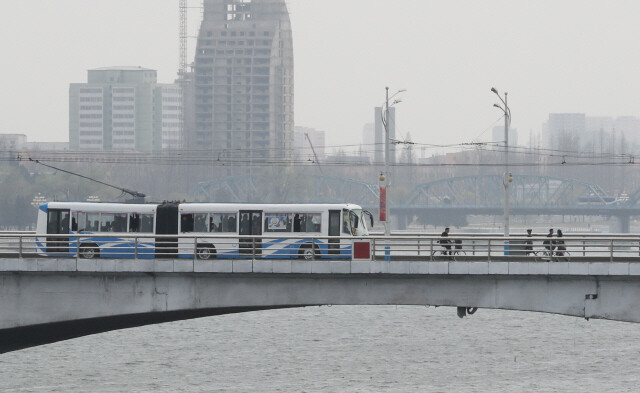hankyoreh
Links to other country sites 다른 나라 사이트 링크
N. Korean document reveals strategy to decrease reliance on China, Japanese press reports

A document titled “National Economic Development Strategy (2016–2020)” that North Korea adopted in the 2016 congress of the Workers’ Party of Korea (WPK) stated that the country needs to become less dependent on China, the Japanese press has reported.
Japanese newspaper the Mainichi Shimbun reported on Apr. 21 that the strategy document set the goal of achieving an average annual economic growth rate of 8% and proposed “reducing our reliance on China and expanding foreign trade in a number of areas, including Russia, Southeast Asia, and the Middle East.” While this strategy was adopted in the 7th WPK Congress, held in May 2016, after a hiatus of 36 years, the specific details and figures in the strategy had not been previously disclosed. The Mainichi explained that the strategy document had recently been acquired by Cho Yun-yeong, a Korean-Japanese researcher on North Korea.
This document said that China represented 71.6% of North Korea’s trade value in 2014; Russia, 4.2%; and Germany, 0.8%. “China accounts for an overwhelming share of trade. We’ve been unable to move away from our dependence on China,” the document said. The solution posited by the document was the diversification of foreign trade.
More specifically, North Korea set the goal of increasing the amount of its trade with Russia to US$1 billion by 2020. According to the latest estimate by the South Korean government, North Korea’s trade with Russia amounted to US$77.84 million in 2017. In other words, the North was seeking to increase its trade with Russia more than tenfold in the space of just four years.
The Mainichi Shimbun also said the North Korean document proposed gaining funds needed for building hydroelectric plants from Russia, as well as technical cooperation for upgrading facilities such as the Kim Chaek Iron and Steel Complex and the Musan Iron Mine. North Korea also appears to have drawn up a plan to attract investment from Russian companies in international tourism zones in Wonsan and Mt. Kumgang and an economic development zone in Chongjin, along the the East Sea, in order to “build a cooperative network for producing medical products on consignment, processing marine products and developing natural energy.”
The Japanese newspaper predicted that economic cooperation between the two countries could be on the agenda of the summit between North Korean leader Kim Jong-un and Russian President Vladimir Putin, which is likely to be held in Vladivostok on Apr. 24. But given the failure of the second North Korea-US summit, in Hanoi, to live up to its expectations, it won’t be easy for the North to massively boost its trade with Russia, as it hopes to do.
Other ways that the North Korean document suggested trade could be diversified included “invigorating trade with India and Pakistan and getting into the Iranian market.” Major export items specified in the document were magnesia clinker, zinc, machine tools, and cutting equipment, while items for import included crude oil and natural rubber.
By Cho Ki-weon, Tokyo correspondent
Please direct comments or questions to [english@hani.co.kr]

Editorial・opinion
![[Column] Park Geun-hye déjà vu in Yoon Suk-yeol [Column] Park Geun-hye déjà vu in Yoon Suk-yeol](https://flexible.img.hani.co.kr/flexible/normal/500/300/imgdb/original/2024/0424/651713945113788.jpg) [Column] Park Geun-hye déjà vu in Yoon Suk-yeol
[Column] Park Geun-hye déjà vu in Yoon Suk-yeol![[Editorial] New weight of N. Korea’s nuclear threats makes dialogue all the more urgent [Editorial] New weight of N. Korea’s nuclear threats makes dialogue all the more urgent](https://flexible.img.hani.co.kr/flexible/normal/500/300/imgdb/original/2024/0424/7317139454662664.jpg) [Editorial] New weight of N. Korea’s nuclear threats makes dialogue all the more urgent
[Editorial] New weight of N. Korea’s nuclear threats makes dialogue all the more urgent- [Guest essay] The real reason Korea’s new right wants to dub Rhee a founding father
- [Column] ‘Choson’: Is it time we start referring to N. Korea in its own terms?
- [Editorial] Japan’s rewriting of history with Korea has gone too far
- [Column] The president’s questionable capacity for dialogue
- [Column] Are chaebol firms just pizza pies for families to divvy up as they please?
- [Column] Has Korea, too, crossed the Rubicon on China?
- [Correspondent’s column] In Japan’s alliance with US, echoes of its past alliances with UK
- [Editorial] Does Yoon think the Korean public is wrong?
Most viewed articles
- 1[Guest essay] The real reason Korea’s new right wants to dub Rhee a founding father
- 2Why Korea shouldn’t welcome Japan’s newly beefed up defense cooperation with US
- 3[Column] ‘Choson’: Is it time we start referring to N. Korea in its own terms?
- 4New AI-based translation tools make their way into everyday life in Korea
- 5Senior doctors cut hours, prepare to resign as government refuses to scrap medical reform plan
- 6Opposition calls Yoon’s chief of staff appointment a ‘slap in the face’
- 7[Column] Park Geun-hye déjà vu in Yoon Suk-yeol
- 8Terry Anderson, AP reporter who informed world of massacre in Gwangju, dies at 76
- 9N. Korean hackers breached 10 defense contractors in South for months, police say
- 10Will NewJeans end up collateral damage in internal feud at K-pop juggernaut Hybe?